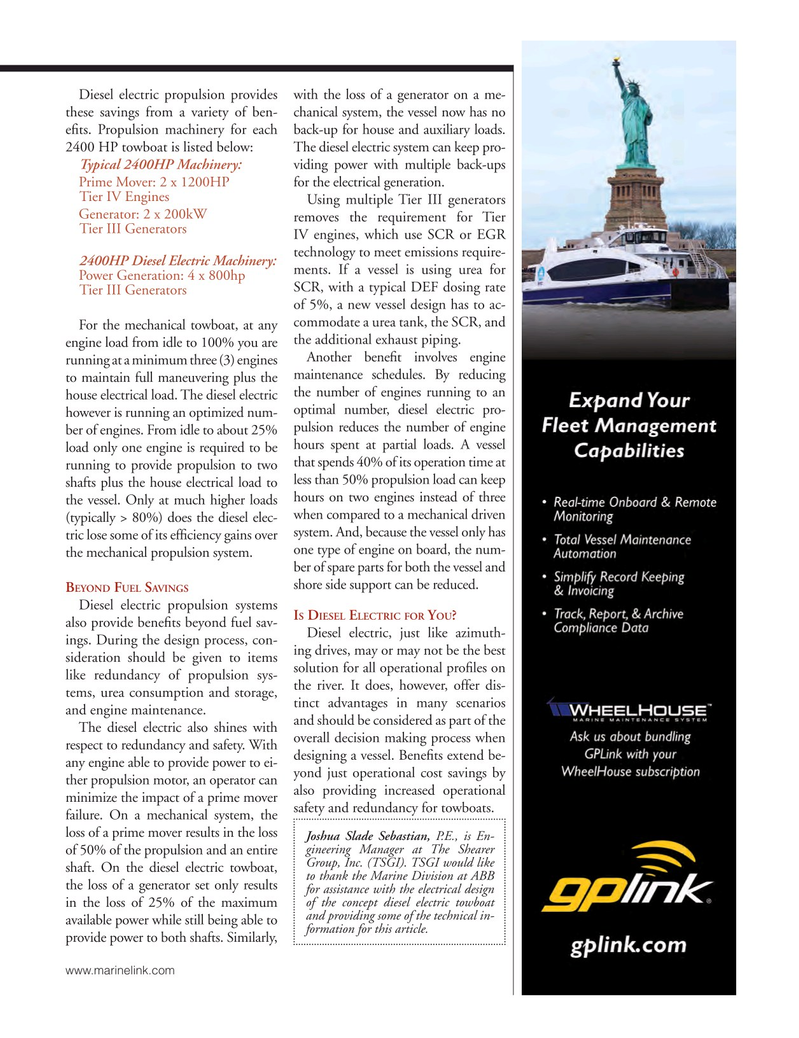
Page 29: of Marine News Magazine (March 2018)
Pushboats, Tugs & Assist Vessels
Read this page in Pdf, Flash or Html5 edition of March 2018 Marine News Magazine
Diesel electric propulsion provides with the loss of a generator on a me- these savings from a variety of ben- chanical system, the vessel now has no e? ts. Propulsion machinery for each back-up for house and auxiliary loads. 2400 HP towboat is listed below: The diesel electric system can keep pro-
Typical 2400HP Machinery: viding power with multiple back-ups
Prime Mover: 2 x 1200HP for the electrical generation.
Tier IV Engines
Using multiple Tier III generators
Generator: 2 x 200kW removes the requirement for Tier Tier III Generators
IV engines, which use SCR or EGR technology to meet emissions require- 2400HP Diesel Electric Machinery: ments. If a vessel is using urea for
Power Generation: 4 x 800hp
SCR, with a typical DEF dosing rate Tier III Generators of 5%, a new vessel design has to ac-
For the mechanical towboat, at any commodate a urea tank, the SCR, and engine load from idle to 100% you are the additional exhaust piping.
Another bene? t involves engine running at a minimum three (3) engines to maintain full maneuvering plus the maintenance schedules. By reducing house electrical load. The diesel electric the number of engines running to an optimal number, diesel electric pro- however is running an optimized num- ber of engines. From idle to about 25% pulsion reduces the number of engine load only one engine is required to be hours spent at partial loads. A vessel running to provide propulsion to two that spends 40% of its operation time at shafts plus the house electrical load to less than 50% propulsion load can keep the vessel. Only at much higher loads hours on two engines instead of three when compared to a mechanical driven (typically > 80%) does the diesel elec- tric lose some of its ef? ciency gains over system. And, because the vessel only has one type of engine on board, the num- the mechanical propulsion system.
ber of spare parts for both the vessel and shore side support can be reduced.
B F SEYOND UEL AVINGS
Diesel electric propulsion systems I D E Y ?
S IESEL LECTRIC FOR OU also provide bene? ts beyond fuel sav-
Diesel electric, just like azimuth- ings. During the design process, con- sideration should be given to items ing drives, may or may not be the best solution for all operational pro? les on like redundancy of propulsion sys- tems, urea consumption and storage, the river. It does, however, offer dis- tinct advantages in many scenarios and engine maintenance.
The diesel electric also shines with and should be considered as part of the respect to redundancy and safety. With overall decision making process when designing a vessel. Bene? ts extend be- any engine able to provide power to ei- ther propulsion motor, an operator can yond just operational cost savings by minimize the impact of a prime mover also providing increased operational failure. On a mechanical system, the safety and redundancy for towboats.
loss of a prime mover results in the loss
Joshua Slade Sebastian, P.E., is En- gineering Manager at The Shearer of 50% of the propulsion and an entire
Group, Inc. (TSGI). TSGI would like shaft. On the diesel electric towboat, to thank the Marine Division at ABB the loss of a generator set only results for assistance with the electrical design of the concept diesel electric towboat in the loss of 25% of the maximum and providing some of the technical in- available power while still being able to formation for this article. provide power to both shafts. Similarly, www.marinelink.com
MN March18 Layout 18-31.indd 29 MN March18 Layout 18-31.indd 29 2/26/2018 9:54:25 AM2/26/2018 9:54:25 AM

 28
28

 30
30
